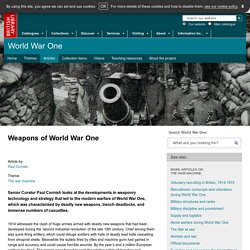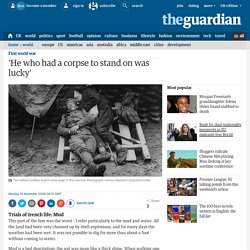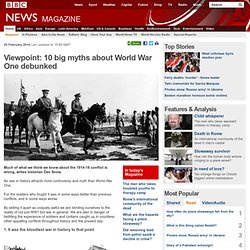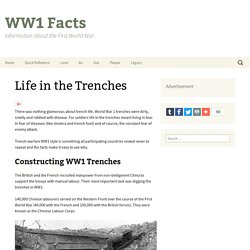

Machine Guns - WW1 Uncut: Dan Snow. World War One on TV and Radio. Weapons of World War One. Senior Curator Paul Cornish looks at the developments in weaponry technology and strategy that led to the modern warfare of World War One, which was characterised by deadly new weapons, trench deadlocks, and immense numbers of casualties. 1914 witnessed the clash of huge armies armed with deadly new weapons that had been developed during the ‘second industrial revolution’ of the late 19th century.

Chief among them was quick-firing artillery, which could deluge soldiers with hails of deadly lead balls cascading from shrapnel shells. Meanwhile the bullets fired by rifles and machine guns had gained in range and accuracy and could cause horrible wounds. By the year’s end a million European soldiers lay dead. The armies were forced to seek the relative safety of trenches and dugouts. Trench warfare Old weapons were revived or re-invented to wage trench warfare effectively. First World War Weapons. Url?sa=t&rct=j&q=&esrc=s&source=web&cd=11&cad=rja&uact=8&ved=0CFoQFjAKahUKEwi6_NSq_q_HAhXMORQKHdkrCAk&url= The trench experience. 10 Things That Could Have Saved Your Life In The Trenches.
Beauty from the Battlefield: 10 Pieces of Trench Art. Living in the Trenches. First world war: Soldiers reports on the trials of trench life. Trials of trench life: Mud This part of the line was the worst - I refer particularly to the mud and water.

All the land had been very churned up by shell explosions, and for many days the weather had been wet. It was not possible to dig for more than about a foot without coming to water. Mud is a bad description: the soil was more like a thick slime. When walking one sank several inches in and, owing to the suction, it was difficult to withdraw the feet. Most of the night was spent digging men out of the mud.
Back to battalion headquarters was about 800 yards; at night it would take a runner [an orderly taking messages] about two hours to get there. Flies The house flies were a perfect plague. . • Both extracts from A Very Unimportant Officer by Captain Alexander Stewart, edited by Cameron Stewart (Hodder & Stoughton, 2008). The cold One afternoon, towards Christmas, a harder frost settled upon the vacant battlefield. . • From The Christmas Truce, a report by Henry Williamson (1915). Rats.
Life in the Trenches - History Learning Site. Trenches and life within those trenches have become an enduring topic from World War One.

Throughout the war millions of soldiers experienced and endured the horrors of trench warfare. Some wrote down for posterity what these experiences were and as time has moved on from World War One more and more of these written documents – frequently in the form of a diary – have come to light. Others wrote about their experiences in book-form. On the British side “Goodbye to All That” by Robert Graves is considered a classic.
For the Germans, “All Quiet on the Western Front” by Erich von Remarque was considered to be such a potent anti-war book that Hitler banned it. BBC iWonder - How did 12 million letters reach WW1 soldiers each week? Pigeon vs telephone: which worked best in the trenches? Viewpoint: 10 big myths about World War One debunked. 25 February 2014Last updated at 15:45 GMT Much of what we think we know about the 1914-18 conflict is wrong, writes historian Dan Snow.

No war in history attracts more controversy and myth than World War One. For the soldiers who fought it was in some ways better than previous conflicts, and in some ways worse. By setting it apart as uniquely awful we are blinding ourselves to the reality of not just WW1 but war in general. We are also in danger of belittling the experience of soldiers and civilians caught up in countless other appalling conflicts throughout history and the present day. 1. Fifty years before WW1 broke out, southern China was torn apart by an even bloodier conflict. Although more Britons died in WW1 than any other conflict, the bloodiest war in our history relative to population size is the Civil War, which raged in the mid-17th Century. 2. In the UK around six million men were mobilised, and of those just over 700,000 were killed. 3. 4. 5.
BBC iWonder - How did so many soldiers survive the trenches? BBC Schools - Life in the trenches. 31 October 2014Last updated at 15:07 Two British soldiers standing in a flooded communication trench during World War One On the Western Front, the war was fought in trenches. Trenches were long, narrow ditches dug into the ground where soldiers lived all day and night. There were many lines of German trenches on one side and many lines of Allied trenches on the other.
In the middle, was no man's land, so-called because it did not belong to either army. Rest. Life In The Trenches. There was nothing glamorous about trench life.

World War 1 trenches were dirty, smelly and riddled with disease. For soldiers life in the trenches meant living in fear. In fear of diseases (like cholera and trench foot) and of course, the constant fear of enemy attack. Trench warfare WW1 style is something all participating countries vowed never to repeat and the facts make it easy to see why. History - World Wars: Shell Shock during World War One. Soldiersequipment. BBC Schools - Trench food. 18 February 2014Last updated at 17:06 British soldiers eating hot rations in the Ancre Valley during the Battle of the Somme, October 1916 Maconochie's meat stew advertisement Even though food was very short in Britain during World War One, families often sent parcels to their fathers and brothers fighting at the front.

The parcels contained presents of chocolate, cake, tobacco and tinned food. At the beginning of the war, soldiers got just over one pound of meat, the same amount in bread and eight ounces of vegetables each day. Some soldiers worked in field kitchens which were set up just behind the trenches to cook meals for the soldiers who were fighting. By 1917 the official ration for the average British 'Tommy' was much smaller. 'Maconchie's meat stew' and hard biscuits was a meal that many soldiers ate. 18 February 2014Last updated at 17:06. 10 Photos of Life in the Trenches. BBC Bitesize - What was it like in a World War One trench?